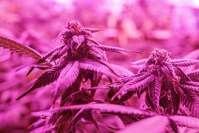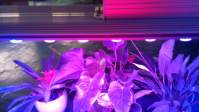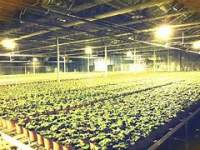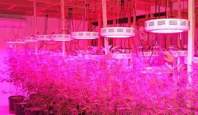With the development of technology, indoor planting has developed soilless planting, hydroponic planting and other planting methods, which not only improve the utilization of land and water and fertilizer, but also promote the vigorous development of agriculture.
Hydroponic cultivation is to create a relatively closed environment that can store nutrient solution through specific facilities, and keep the water, fertilizer, gas, heat and other conditions required for root growth relatively stable, and all or part of the root system is "immersed" in the nutrient solution. Cultivation methods.
When planting indoors, LED plant lights can be used to supplement light during hydroponic cultivation. LED plant lights are made according to the absorption and utilization of sunlight by plant growth, and the spectrum and light intensity meet the requirements. It can be used to supplement light for vegetables, seedlings, fruits, and flowers. It can not only promote the progress of photosynthesis, but also achieve the effects of increasing production and increasing, launching in advance, and enhancing quality.
Advantages of LED plant lights in hydroponics
1. It can be well used in hydroponic cultivation, and can be illuminated at close range to provide sufficient light to plants;
2. The wavelength can be customized, which can replace high-pressure sodium lamps, halogen lamps, and fluorescent lamps with 3-5 times the power, saving 80% of electric energy;
3. Long service life, up to 50,000 hours;
4. The ratio of lamp beads can be freely matched to meet the needs of different plants and different growth stages;
5. It can control the growth rate of plants and predict the maturity time of the market;
6. LED plant light is a kind of energy-saving, environmentally friendly and efficient plant growth light.
7. The heat emitted is much lower than traditional plant growth lamps.
8. No standard power socket connectors for drivers or cooling fans are required.
9. Promote early maturity of plants, increase production, and improve the quality of melons and fruits;
10. Ensure the taste of vegetables in greenhouses and realize off-season cultivation;
11. Inhibit the reproduction of germs and pests, and make it green without pollution.
Significance of Hydroponic Plants
1. Adapt to market demand
Annual cultivation can be carried out on the same site. Leafy vegetables are not easy to store, but in order to meet market demand, annual production is required. Hydroponic cultivation is very simple. You only need to plant seedlings in the planting holes. For example, lettuce can be sown, planted, harvested at any time, and produced continuously without interruption, so hydroponics is suitable for planned and contracted production.
2. Solve the problem of anti-seasonal supply of vegetables
Hydroponic vegetables have a short growth cycle, and the hydroponic method belongs to facility production, which is generally not easily damaged by natural weather. Planted throughout the year, fresh vegetables can also be supplied in off-season to obtain higher profits.
3. No need to change the nutrient solution midway
No need to change the nutrient solution midway. Due to the long growth period of fruits and vegetables, even if there is no major physiological disease, in order to ensure the balance of nutrients in the nutrient solution, it is necessary to renew the nutrient solution in half or full amount.
4. High economic benefits
Hydroponic leafy vegetables can avoid continuous cropping obstacles, and the multiple cropping index is high. The facility operation rate is as high as 20 crops a year, and the production economic benefits are high. For this reason, generally leafy vegetables are often carried out by hydroponics.
Attention should be paid to the LED plant light hydroponic supplement light:
Appropriate lighting time
In terms of the duration of light, most plants have a natural circadian rhythm. This can also be imitated with the artificial light in the greenhouse. There is already a greenhouse lighting system, which can be programmed with the timer function, so that the LED plant light can slowly fall on the plants like nature.
Appropriate light intensity
The light intensity depends on the photon flux density, that is, how many photosynthetic photons are in the radiation. It can be quantified as micromoles per square meter and second (μmol/m2s). For comparison: Direct solar radiation up to 2,000 μmol/m2s. Your greenhouse plants usually don't need as much light. As the guiding principle of light intensity in artificial greenhouse, 600μmol/m2s is enough to achieve good growth.
Reasonably distribute the light evenly
Measure the floor area. Multiply the length by the width to get the area of the hydroponic area in square meters. You can make the right choice based on how much power to provide per square meter, that is, how many LED plant lights are installed per square meter. In this way, each lamp can be evenly distributed, so that the outer edge will receive strong light, so that the light will be more uniform, and the growth of plants will be more effective.
Appropriate light color
Light travels from the sun to the earth as electromagnetic waves of different wavelengths. The wavelength range visible to the human eye is between 380 and 750 nanometers (NM), which roughly corresponds to the light that plants can use for photosynthesis. The wavelength of light determines the so-called light color. The short wave turns blue, and the long wave turns red. Light waves around 500 nautical miles are green and reflected by plants. This phenomenon is also called green space because less photosynthesis can be used to use green light. You should not rely on greenhouse lighting that only combines blue and red light without any green part, because it is still very common. Because this can shut down the weaker photosynthesis and complete plant growth under green light.
Vertical agriculture is the trend of future agriculture. Hydroponic cultivation is an innovative cultivation method in vertical agriculture. LED plant lights are also the trend of indoor planting to supplement light. With the continuous advancement and development of technology, the two will definitely be a perfect combination. Vertical agriculture and LED plant lights promote the development of each other.






